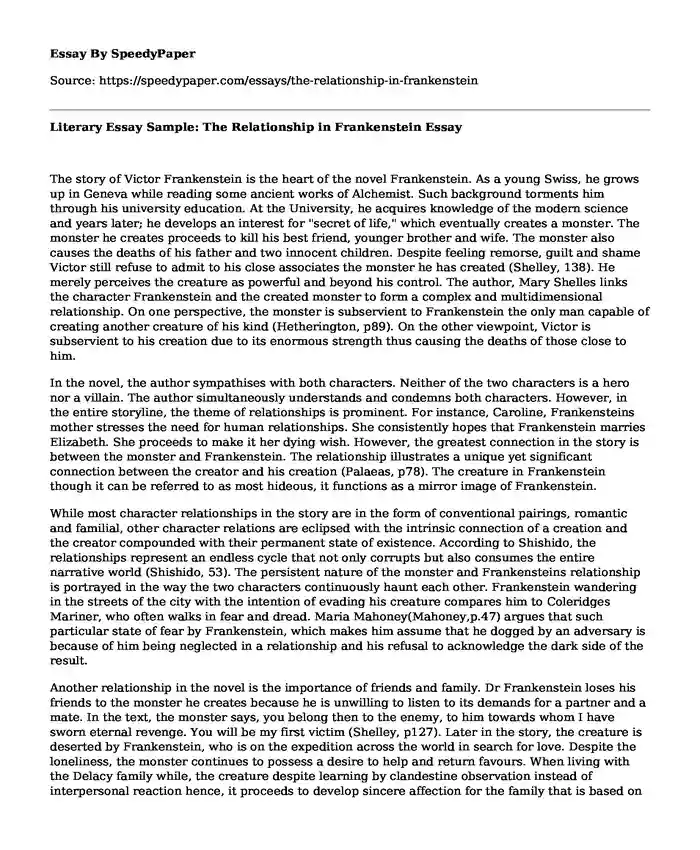
| Type of paper: | Essay |
| Categories: | Relationship Frankenstein Romantic literature |
| Pages: | 3 |
| Wordcount: | 774 words |
The story of Victor Frankenstein is the heart of the novel Frankenstein. As a young Swiss, he grows up in Geneva while reading some ancient works of Alchemist. Such background torments him through his university education. At the University, he acquires knowledge of the modern science and years later; he develops an interest for "secret of life," which eventually creates a monster. The monster he creates proceeds to kill his best friend, younger brother and wife. The monster also causes the deaths of his father and two innocent children. Despite feeling remorse, guilt and shame Victor still refuse to admit to his close associates the monster he has created (Shelley, 138). He merely perceives the creature as powerful and beyond his control. The author, Mary Shelles links the character Frankenstein and the created monster to form a complex and multidimensional relationship. On one perspective, the monster is subservient to Frankenstein the only man capable of creating another creature of his kind (Hetherington, p89). On the other viewpoint, Victor is subservient to his creation due to its enormous strength thus causing the deaths of those close to him.
In the novel, the author sympathises with both characters. Neither of the two characters is a hero nor a villain. The author simultaneously understands and condemns both characters. However, in the entire storyline, the theme of relationships is prominent. For instance, Caroline, Frankensteins mother stresses the need for human relationships. She consistently hopes that Frankenstein marries Elizabeth. She proceeds to make it her dying wish. However, the greatest connection in the story is between the monster and Frankenstein. The relationship illustrates a unique yet significant connection between the creator and his creation (Palaeas, p78). The creature in Frankenstein though it can be referred to as most hideous, it functions as a mirror image of Frankenstein.
While most character relationships in the story are in the form of conventional pairings, romantic and familial, other character relations are eclipsed with the intrinsic connection of a creation and the creator compounded with their permanent state of existence. According to Shishido, the relationships represent an endless cycle that not only corrupts but also consumes the entire narrative world (Shishido, 53). The persistent nature of the monster and Frankensteins relationship is portrayed in the way the two characters continuously haunt each other. Frankenstein wandering in the streets of the city with the intention of evading his creature compares him to Coleridges Mariner, who often walks in fear and dread. Maria Mahoney(Mahoney,p.47) argues that such particular state of fear by Frankenstein, which makes him assume that he dogged by an adversary is because of him being neglected in a relationship and his refusal to acknowledge the dark side of the result.
Another relationship in the novel is the importance of friends and family. Dr Frankenstein loses his friends to the monster he creates because he is unwilling to listen to its demands for a partner and a mate. In the text, the monster says, you belong then to the enemy, to him towards whom I have sworn eternal revenge. You will be my first victim (Shelley, p127). Later in the story, the creature is deserted by Frankenstein, who is on the expedition across the world in search for love. Despite the loneliness, the monster continues to possess a desire to help and return favours. When living with the Delacy family while, the creature despite learning by clandestine observation instead of interpersonal reaction hence, it proceeds to develop sincere affection for the family that is based on friendship (Palaeas, p67). The level of interactions depicted from the relationship is that of a master and an ignorant slave. Though it performs duties like bringing firewood and clearing paths through the snow, it remains unrewarded. However, his demand for a mate exudes the human desire for love.
Although Frankenstein can identify with his creature at every moment of self-indulgent when he says that his vampire and own spirit is let losses from the grave and has come to destroy everyone close to him, (Shelley, P.60), shows the vengeance by his creation after he neglected it. Therefore, the continuous reappearance of his creation is equated to Freuds theory of inevitable return of the subdued.
Cited From
Hetherington, Naomi. "Creator and Created in Mary Shelley's Frankenstein."The Keats-Shelley Review (2013).
Mahoney, Maria F. The meaning in dreams and dreaming: The Jungian viewpoint. Lyle Stuart, 1966.
Palaeas, Maria. "The Importance of Being Ernest in Mary Shelley's Frankenstein: A Study in Literary Onomastics." Names (2013).
Shelley, Mary Wollstonecraft. Frankenstein, Or, The Modern Prometheus 1818. Engage Books, 2008.
Shishido, David Christopher. "Apotheosis Now: A Hegelian Dialectical Analysis of Mary Shelleys Frankenstein." Berkeley Undergraduate Journal24.3 (2011).
Cite this page
Literary Essay Sample: The Relationship in Frankenstein. (2019, Oct 16). Retrieved from https://speedypaper.com/essays/the-relationship-in-frankenstein
Request Removal
If you are the original author of this essay and no longer wish to have it published on the SpeedyPaper website, please click below to request its removal:
- Literary Essay Sample on Sea Oak by George Saunders
- Essay Example: Organizational Demographics and Nursing Strategic Plan
- Essay Example: Effectiveness of the Paintings from Amart's Collection
- Economics for the Global Manager: Free Essay about Intel Company
- Art Essay Sample: Representation and Function of Light in Art History
- Abstaining From THC - Paper Example
- Essay Sample on Personal Online Brand
Popular categories




